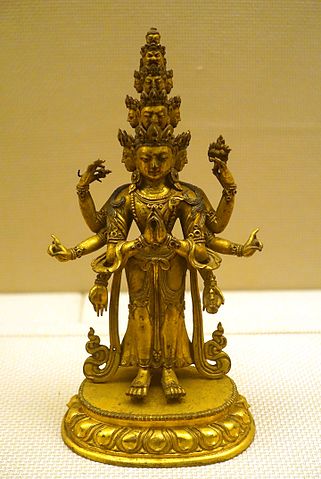Mahayana
The Mahayana (Large Vehicle) is a main direction of today's Buddhism, aside from the Hinayana (Small Vehicle) and the later Vajrayana. It sees itself as the second rotation of the wheel of the doctrine.
The Mahayana was developed under the influence of greco-buddhism (as in Gandhara). Ashoka the Great, an Indian emperor of the Maurya Dynasty, who ruled almost all of the Indian subcontinent from c. 268 to 232 BCE, finally ordered to spread Buddhism to Asia.
The Mahayana - vehicle was later solidified by Nagarjuna and Asanga and was taught as such about 500 years after Buddha's death.
This Bodhisattva-Yana was initially not a new line, but a view of various monks in the existing nikāyas. The splitting took place after the second buddhist council.
In the Hinayana, the practitioner desires to obtain salvation from suffering. In the Mahayana there is the wish that all beings can attain a true spiritual salvation. While Mahayana teaches about several Bodhisattvas, these are unknown in Hinayana except the coming Bodhisattva Maitreya. But for the initiated these "persons" just symbolize certain forms of sadhanas.
The path of the Mahayana developed two lines through the visions of Asanga and Nagarjuna:
- The lineage of the profound way over Nagarjuna with emphasis on the emptiness (Shunyata) and Prajnaparamita (wisdom from the other shore)
- The lineage of the wide way with Asanga (Vijnaptimatra: 'Only Consciousness'): The development of Bodhicitta and the behavior and rules of a Bodhisattva (Vijñānavāda, Yogacara), later spreading as Ekayana in Asia.
Among the teachings of the third rotation of the wheel of the Dharma are the Vajrayana Mahamudra and the explanations of the Buddha nature as explicated in the Uttara-Tantra-Shastra.
The Dalai Lama said : "The precious awakening mind of bodhicitta, which cherishes other sentient beings more than oneself, is the pillar of the bodhisattva’s practice – the path of the great vehicle. There is no more virtuous mind than bodhicitta. There is no more powerful mind than bodhicitta, there is no more joyous mind than bodhicitta. To accomplish one’s own ultimate purpose, the awakening mind is supreme. To accomplish the purpose of all other living beings there is nothing superior to bodhicitta. The awakening mind is the unsurpassable way to accumulate merit. To purify obstacles bodhicitta is supreme. For protection from interferences bodhicitta is supreme. It is the unique and all-encompassing method. Every ordinary and supra-mundane power can be attained through bodhicitta. Thus it is absolutely precious."
“The precious awakening mind of bodhicitta, which cherishes other sentient beings more than oneself, is the pillar of the bodhisattva’s practice—the path of the great vehicle.”
== Mahayana - Sutras ==
The Mahayana, during its spread, produced a series of his own writings, which include :
- the Prajnaparamita-Sutras,
- the Aṣṭasāhasrikā-Sutra,
- the Pañcavimśātisāhasrikā-Prajñāpāramitā-Sutra,
- the Heart-Sutra,
- the Diamant-Sutra,
- the Lotus-Sutra ,
- the Vimalakirti-Sutra,
- the Avatamsaka-Sutra (with the Gandavyuha-Sutra)
- the Nirvana-Sutra,
- the Lankāvatāra-Sutra,
- the Samadhiraja-Sutra,
- the Sutra of the golden light(Arya-Mahayana),
- the Samadhinirmocana-Sutra,
- the Lalitavistara-Sutra as Buddha-Biography of Mahayana,
- the Brahmajāla-Sutra,
- the Śūraṅgama-Sutra,
- the Ullambana-Sutra,
- the Medicine-Master-Sūtra,
- the Plattform-Sutra.
as well as the five Buddha Maitreya writings on Asanga and Vasubandhu:
- Mahayanasutralamkara(Jewelry of the Mahayana Sutras),
- Dharmadharmatavibhaga (Distinguishing the facts from their true nature)
- Ratnagotravibhaga - Uttara Tantra Shastra - about Buddha - Nature
- Abhisamayalamkara
- Madhyantavibhaga
In addition to Prajñāpāramitā(highest wisdom of the other shore), an adapted form of the indian Tara - cult was introduced.
Chinese Buddhism had furthermore the three sutras of the Pure Land, ie. the Sukhāvatīvyūha-Sūtra, the Sutra of Immeasurable Life, the small Pure-Land Amitabha Sutra, the Amida Sutra, the Amitāyurdhyāna Meditation Sutra and the Contemplation Sutra.
East asian Mahayana saw the Tathâgatagarbha(Buddha-Nature, dharma-dhatu) as the essence of all beeings, comparable to the Dharmakaya of Vajrayana.
== Literature ==
- Uttaratantra DJKR PDF
- Hisao Inagaki, Harold Stewart (transl.): The Three Pure Land Sutras, Berkeley: Numata Center for Buddhist Translation and Research 2003. ISBN 1-886439-18-4 (PDF; 1,2 MB)
- Giebel, Rolf, transl. (2006) unter CC3, The Vairocanābhisaṃbodhi Sutra, Numata Center for Buddhist Translation and Research, Berkeley, ISBN 978-1-886439-32-0 (PDF; 1,6 MB); (Translated from the Chinese Taishō Volume 18, Number 848)
- McRae, John (2004). The Sutra of Queen Śrīmālā of the Lion's Roar and the Vimalakīrti Sutra. Numata Center for Buddhist Translation and Research. ISBN 1886439311
- The Lion's Roar of Queen Śrīmālā: A Buddhist Scripture on the, Alex Wayman - Hideko Wayman,1990, Motilal Banarsidass, ISBN-10: 8120807316 ISBN-13: 978-8120807310
- Lalitavistara Sutra
- Mahayana Texts
- Siksha-Samuccaya, a compendium of Buddhist doctrine; Santi-Deva; Bendall, Cecil, 1856-1906
- Mahayana Text & Teachings
- Mahayana texts and sutras
- Mahayana Buddhist Meditation: Theory and Practice, Minoru, Jones, Elvin W. ,Kiyota, Motilal Banasidass Publishers, 2009, ISBN-10: 812080760X ISBN-13: 978-8120807600 ASIN: B0082ROD92
- Aashvagosha : Die Erweckung des Glaubens
- Wiinters : Thinking in Buddhism : Nagarjunas Middle way
- Nāgārjuna's Middle Way, Dvid J.
- Wiki about Mahayana
- Wiki about the Mahayana-Sutras
- Mantrayana - the vehicle of mantra
- Rigpawiki : Uttaratantra Shastra
of Spirituality
universal-path.org
